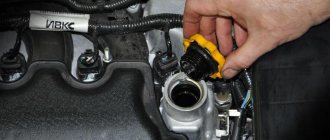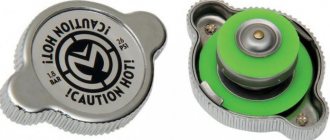What pressure should the fuel injector pump produce?
Pressure characteristics in an automobile fuel system are one of the most important parameters used during diagnostics. The behavior of the vehicle in various operating modes directly depends on this indicator. Using pressure data, the condition of various elements of the fuel system, for example, the pump, is studied.
How to buy a quality device?
The price for a VAZ 2110 fuel pump in market conditions will be 2 times lower than in a specialized store. The equipment is in durable and sealed packaging. Inside the package is purified gasoline. If you smell gasoline, then the seal of the packaging is broken and there is a possibility of corrosion forming inside the gasoline pump. Submerged equipment is lubricated and cooled by fuel. When using low-quality additives and gasoline, internal electrical mechanisms are corroded. If additional substances are not used in the operation of the device (dry), then the brushes wear off and it overheats. The service life of the equipment is longer. Some car owners are planning to replace the VAZ 2110 Bosch fuel pump, the characteristics and pressure of which are not normal only due to long-term use. Its pressure can be 6-7 atmospheres. It was amazing to hear from an experienced driver his method for testing the fuel pump. To do this, he took a jar of water, turned it on on the battery, and by the flow of liquid he realized that the power of the gas pump had decreased.
Rail pressure indicator
It is extremely important to check the indicator in the fuel rail at the same time.
On the other hand, there is no specific value for the pressure in the ramp. The norm for the performance of all elements of the fuel system is considered to be higher than 2.8 bar. As for the top point, there are no restrictions.
Here, for example, is what data should be there if there are no difficulties in the functioning of the vehicle and its elements.
If the indicator does not correspond to the factory values, we can conclude that the filters, pump or RTD (sensor) are faulty.
The pressure indicator on systems without return is slightly different. Here it can vary between 3.6 - 4 atm.
How to check the fuel pressure in the fuel rail yourself
The next step is to check the fuel pressure in the fuel system (fuel rail). The stability of the engine when driving in various modes directly depends on the fuel pressure. For such diagnostics, you can purchase a special device, which consists of a special pressure gauge and various adapters for connecting to the fuel rail (ramp).
- Before starting work, you should take into account the increased risk of fuel fire, which may spill into the engine compartment. To minimize risks, it is necessary to take precautions, and it is also recommended to cover the car generator and other elements under the hood with thick cloth or other available material.
- Then you will need to relieve the fuel pressure in the system by turning off the fuel pump fuse. The specified fuse is located on the fuse panel. To accurately detect the element, it is necessary to study the operating manual of the specific vehicle. Then you need to start the engine with the fuel pump turned off. The engine will stall after using up the remaining fuel in the system.
- The next step is to connect the pressure gauge to the fuel rail. The connection point is most often closed with a plastic plug that needs to be unscrewed. After unscrewing, access to a special valve will open. This valve resembles a nipple installed on the wheels of a car. Then the fitting must be removed. It is worth considering that when you try to remove it, gasoline may leak, so you should prepare rags in advance.
- Now you can connect the pressure gauge hose to the ramp, checking the reliability of its fastening. After this, the pressure gauge itself should be brought out through the edge of the hood onto the windshield. Next, the fuel pump fuse is installed in place and the engine is started. After turning on the ignition, the pressure gauge readings are recorded.
- Different car models may have different fuel pressures in the fuel system. For example, VAZ injection 1.6-liter units have a pressure in the fuel rail of about 4 atmospheres. At normal pressure in the rail, the pressure gauge readings should be within the range of about 300-380 kPa.
- Next, you will need to accelerate the car to 40-50 km/h in third gear, paying attention to the pressure gauge readings. With normal fuel pump performance, they should remain at the same level as when the engine was started.
It should be added that a regular pressure gauge, which is used to measure the air pressure in car tires, can also be used to measure fuel pressure. It is worth considering that such pressure gauges are initially intended for measuring high pressure up to 16 atmospheres, while fuel pressure gauges are limited to a limit of about 6 atmospheres. Also, the air pressure gauge may have a noticeable error.
Different measuring methods
In addition to measuring against the wall, there are many other ways to measure yourself. One of the options for checking the fuel supercharger is the “plug” diagnosis. In this case, the return line is clamped for two seconds, the engine starts, and the pressure reading is taken.
Another testing option. The speed of the power plant increases to three thousand revolutions per minute. At the same time, you need to monitor the instrument readings. If the pressure drops to 0, this is a sign of a “dead” pump.
The pressure on the ramp is measured as follows:
Measurements are made in different ways:
Troubleshooting
The main symptoms of a malfunction of the VAZ 2110 fuel pump are engine interruptions in various operating modes, lack of pressure in the fuel system, loss of acceleration dynamics, increased fuel consumption, or complete failure when trying to start the engine.
The first step is to check the functionality of the pump. When you turn on the ignition, you should hear a slight whirring sound from the pump under the rear seat for a few seconds.
If the engine is running, it is necessary to check the fuel supply pressure using a pressure gauge; the fuel supply pressure to the injector should be 3.5 - 4 atmospheres. If the sound of the fuel pump is not heard, if you have an electrical tester, you can check whether power is being supplied to the pump.
To do this, you need to remove the back seat of the VAZ 2110, the decorative cover, and the terminal from the fuel pump housing, turn on the key to crank the starter, if the tester does not receive power, you need to check the relay, fuse or wiring trace for a break! If there is power, the fuel pump needs to be replaced.
The serviceability of the relay can be checked by replacing it with a working one from the fuse box, for example the high beam headlight relay. When replacing a new relay, you need to pay attention to the manufacturer and the recommendations of a spare parts specialist in the store; it is better not to save on the cost of the relay.
Injection pump pressure on a Mercedes
This is a high pressure pump installed on diesel cars and some gasoline cars.
This is how pressure is measured.
The normal value should vary within 3 volts. If it is less, you need to raise the speed of the power plant and keep it within 2000 rpm. Adjust the pressure bolt in this mode by rotating clockwise. At the same time, you need to look at the device to stop rotation as soon as the pressure reaches the standard value of 3 volts.
If the pressure does not want to return to place, you can draw conclusions about a fuel leak or a malfunction of the fuel system elements, including the pump.
Video: how to measure the pressure of injection pump 4g94
Source
Replacing the fuel pump on injection vehicles VAZ 2110/2112
- screwdriver with Phillips bit;
- thin slotted screwdriver;
- key to 17;
- key to 7;
- key to 5.
Procedure for replacing the fuel pump:
- Disconnect the negative terminal from the battery.
- Open the gas tank cap for a few seconds to reduce the pressure inside.
- Remove the rear seat, unscrew the screws, and open the hatch.
Unscrew the two screws securing the protective hatch
Disconnect the electrical connector
Using a 17 wrench, unscrew the nuts of the pump fittings
Using a 7 wrench, unscrew the 8 nuts securing the fuel module flange
Using a screwdriver, unscrew the 2 screws securing the fuel level sensor
Use a screwdriver to remove the clamps on the guides
Using a slotted screwdriver and a 5mm wrench, unscrew the bolts securing the fuel pump cover
We remove the fuel pump from the housing and install a new one in its place.
Having completed the assembly, we check the operation of the new fuel pump.
The process of replacing a VAZ 2110/2112 fuel pump, regardless of its design, does not require any special skills and can be done independently. However, if you are not particularly confident in your own abilities, it is better to contact the nearest car service center.
The article will be of interest to those who are looking for information about the technical characteristics and performance of the VAZ 2110 gasoline pump. Gasoline engines can be equipped with electrical or mechanical devices. For the VAZ 2110 car, the electric fuel pump of the Bosch brand is the most popular, as it has universal sizes, is always available in stores and is inexpensive.
Gasoline pump for carburetor VAZ 2107
One of the mechanisms of the power supply system of any engine is the fuel pump. The startup and operation of the power unit directly depends on its performance. Mechanical fuel pumps of the diaphragm type DAAZ 2101 were installed on carburetor “sevens”. Thanks to the simple design, the mechanism is repairable. However, it often causes problems for Zhiguli owners. Therefore, it is worth dwelling on the operation and malfunctions of this unit in more detail.
Main functions
The job of the fuel pump is to move fuel from the tank to the carburetor.
The design of the unit is not ideal, so it is one of the weak points in the car. This is explained by the fact that the impact of constant loads and low quality gasoline lead to natural wear and tear of the elements. This is what causes the device to fail. If a problem occurs with the pump, the engine begins to work intermittently or stops functioning altogether.
Design and operating principle
The mechanism is made of several parts connected to each other by fastening elements. There are two fittings in the upper part of the body through which fuel is supplied and pumped into the carburetor. The design includes a lever that allows you to manually pump gasoline from the tank into the fuel system, which is important after the car has been parked for a long time. The main elements of the node are:
The principle of operation of a classic fuel pump is based on creating the pressure necessary to maintain the required fuel level in the carburetor chamber. Thanks to the diaphragm, the flow of gasoline stops or decreases when a maximum pressure value is established in the fuel line. On carburetor “sevens” the fuel pump is located under the hood on the left side of the cylinder block. It is secured to two studs through a thermal spacer and gaskets, which are also used for adjustment. The spacer is also a guiding part for the pump rod.
The device operates in the following order:
Which fuel pump is better
When there are problems with the fuel pump, the question of choosing a new device often arises. Owners of Zhiguli cars mainly prefer products of two. If problems arise with the factory mechanism, for example, when it overheats, many change it to the second option, explaining that Pekar pumps do not have a tendency to form a vapor lock, which causes defects in the operation of the device in hot weather. In fact, this opinion is wrong, since they also have this problem, as evidenced by numerous reviews from car owners. It is also worth considering that Pekar costs 1.5–2 more than DAAZ. Therefore, a standard fuel pump is the best choice based on criteria such as reliability, price and quality. The cost of a factory pump is 500–600 rubles.
Table: parameters of different fuel pumps
| Test results | "Baker" | DAAZ | QH | OTA |
| Zero supply pressure (at a crankshaft speed of 2 thousand rpm), kgf/cm² | 0,26 | 0,28 | 0,3 | 0,36 |
| Capacity for free drainage (at a crankshaft speed of 2 thousand rpm), l/h | 80 | 76 | 92 | 74 |
| Suction period at a crankshaft speed of 2 thousand rpm, s | 4 | 13 | 9 | 6 |
| Valve tightness at a pressure of 0.3 kgf/cm² (fuel leakage within 10 minutes), cm³ | 8 | 12 | 8 | 8 |
| Place | 3 | 4 | 1–2 | 1–2 |
QH petrol pumps are manufactured in the UK, while OTA petrol pumps are manufactured in Italy. However, these devices have some features: the QH pump does not have a lever for manual pumping of fuel, and the housing is non-separable. The Italian mechanism has excellent parameters compared to others, but its price is almost 3 times higher than Russian products.
Signs of a fuel pump malfunction
Engine won't start
This is the main symptom of a faulty fuel pump. In the summer heat, a dying fuel pump may appear. The junction of the impeller with the rotor axis expands, and it rotates. You should check the fuel pressure from the rail and from the pump directly.
The service life of the fuel pump is determined by the owner's use of the vehicle. What is required for the fuel pump to last longer and not fail:
- Check the presence of water in the tank. For prevention, pour any pure alcohol into the tank. It mixes with water and burns out through the exhaust. There is a moisture displacer available in stores. Contains isopropyl alcohol.
When purchasing other displacers or desiccants, carefully read the ingredients, as there may not be alcohol, but other chemical compounds may be present that will clean the tank and clog the injectors.
- It is advisable to have a fuel level of at least half the tank. This minimizes the water-gasoline ratio and the pump cools better.
- Change the fuel pump mesh every 30,000 km, and the fine filter (barrel) every 15,000 km. It is in this filter that all sediments and water accumulate. Causes of pump failure due to compressed water mesh are a common occurrence.
The car does not accelerate well
Loss of traction when the fuel pump fails is a fairly common symptom number two. The cylinders begin to work poorly, there is no normal injection by the nozzle, and ignition of the mixture becomes ineffective. The injector produces an uneven spray, and the flow rate of the mixture into the combustion chamber drops. Thus, if the electric fuel pump fails, the engine power is reduced.
If there is a loss of traction, the fuel pump does not necessarily break down. You need to check the filter, fuel line, and fuel pressure regulator for blockages.
Fuel pump drive
The VAZ 2107 fuel pump operates from a pusher (rod) and an eccentric located on the shaft of auxiliary devices (“piglet”, intermediate shaft), which is driven by the timing mechanism through a gear. Auxiliary devices include distributor, oil and fuel pumps.
Operating principle
The drive works as follows:
Fuel pump drive malfunctions
As the fuel supply unit wears out, problems may occur that affect the performance of the latter.
Rod wear
The main sign of a worn-out rod is that the car does not reach the required speed. If the car accelerates, but, having gained speed to a certain value, does not develop it anymore, the reason is precisely the wear of the rod. Recently, the pusher has been made from such low-quality metal that it leads to wear out literally after 500–1000 km. The edge of the rod on the eccentric side is simply flattened, which indicates the need to replace the part.
The fuel pump rod should be 82.5 mm long.
What kind of fuel pumps are installed on VAZ 2110/2112 cars
VAZ 2110/2112 cars, depending on the year of manufacture and the type of engine installed, may differ in the method of supplying fuel to the cylinders.
Table: features of fuel supply systems to engine cylinders depending on vehicle modification
| Model/ modification | Year of issue | Engine volume, cm3 | Number of valves, pcs | Injection system |
| VAZ 21100 | 1996–2000 | 1500 | 8 | Carburetor |
| VAZ 21101 | since 2004 | 1600 | 8 | Injection |
| VAZ 21102 | since 2004 | 1500 | 8 | |
| VAZ 21103 | since 2001 | 1500 | 16 | |
| VAZ 21103M | since 2001 | 1500 | 16 | |
| VAZ 21104M | since 2001 | 1600 | 16 | |
| VAZ 21120 | 1999–2008 | 1500 | 16 | Injection |
| VAZ 21121 | 1999–2008 | 1600 | 8 | |
| VAZ 21122 | 1999–2008 | 1500 | 8 | |
| VAZ 21124 | 2004–2008 | 1600 | 16 | |
| VAZ 21128 | 2004–2008 | 1800 | 16 | |
| VAZ 21123 | 1999–2009 | 1600 | 16 |
Only the first modifications of the VAZ 2110 were equipped with a carburetor injection system. From the factory they were equipped with mechanical fuel pumps of the DAAZ brand (catalog number 2108–1106010). Previously, they had proven themselves well on cars of the Sputnik and Samara series.
A mechanical fuel pump was installed in the engine compartment of the VAZ 2110 to the right of the engine valve cover, and was driven by the camshaft.
All injection VAZ 2110/2112 are equipped with submersible fuel modules. The design of such a module includes:
- electric fuel pump;
- coarse filter;
- fuel level sensor.
The fuel module is installed directly into the vehicle tank. In other words, the gas pump is completely immersed in gasoline. Injection VAZ 2110/2112 were and are equipped with electric fuel pumps of domestic, joint or imported production. These are products of the Utes, Pekar, Saratov plant, as well as the world famous one, the pumps of which are equipped in all modern VAZs. The catalog number of the stock electric pump is 2112–1139009. There are also modifications whose numbers have two additional digits: 02 or 03. Depending on them, products may differ in length and diameter.
Electric fuel pump for VAZ 2107
Increasingly, owners of “classics”, including the VAZ 2107, are installing modern devices on their cars. So, the mechanical fuel pump is replaced with an electric one. The main goal of introducing an electric fuel pump is to get rid of the problems that arise with standard pumps. However, you need to understand that if on injection “sevens” such a mechanism is installed directly in the gas tank, then on carburetor cars it is placed under the hood.
Which one can be installed
As an electric fuel pump, you can install any device designed to work on fuel-injected cars on the “classic”. Based on reviews from Zhiguli car owners, Chinese-made pumps, as well as Magneti Marelli and Bosch, are often used. It is important to know that the product must provide low pressure . A standard mechanical pump produces about 0.05 atm. If the indicator is higher, then the needle valve in the carburetor will simply let fuel through, which will lead to it leaking out.
Installation of an electric fuel pump
To install an electric fuel supply pump on a carburetor “seven”, you will need a certain list of materials:
We carry out the work in the following sequence:
What pressure should be in the fuel system?
The pressure level in the fuel supply circuit depends on the design of the system. In cars where the RTD and the discharge tube - “return” - are located in the engine compartment, the pressure gauge should show 2.7 Bar. The upper and lower permissible limit is 2.7–3.0 Bar. If the measured values are outside the specified range, you should continue the diagnosis and find the cause of the problem.
On many cars, including VAZ, the pressure regulator and the fuel return hose are located next to the fuel pump. The normal manifold pressure for such machines is 3.8 Bar, the maximum value is 4 Bar.
If during the measurement process periodic pressure surges within 0.2 bar are observed, the primary strainer needs to be cleaned or replaced. Typically, it is installed in the gas tank along with an electric pump.
Instructions for diagnosing pressure and repairing a fuel pump
- If the fuel supply is insufficient, this can lead to a decrease in engine power. This is also manifested by the fact that during active acceleration, characteristic jerks may appear. The same applies to driving at higher speeds. So, we remove the rear seat, which is located on the right side of the car. There we find a special metal plate that will need to be unscrewed.
- Now turn on the ignition. You should hear the characteristic sounds of a pump that pumps fuel. If this sound is heard very faintly, you can remove another seat to hear it clearly. But it also happens that there is no sound in this case. As a result, we will need to check the relay, as well as the fuses that control the operation of the fuel pump.
- The next step will be to loosen the fastening clamp, followed by disconnecting the fuel hose from the suction pipe of the fuel pump. The indicated hose is located slightly lower than the current fuel mark in the tank. And, so that gasoline does not start leaking, you need to close its hole with any suitable object that is at hand. Most often, we are talking about a bolt of the appropriate diameter.
Check the fuel hose for damage- Now we disconnect the fuel hose, and then lower it, simply pointing it down, finding the most convenient position. Next, you can tightly close the hole in the hose with your finger, and use the manual fuel pumping lever to pump the liquid several times. You should feel a characteristic force, which is provoked by the presence of resistance from a tense spring that is compressed. We are talking about a spring related to the diaphragm on the lever. If such an effect is not observed, then it is necessary to slightly turn the engine crankshaft, using a special fastening bolt that holds the pulley, to the desired mark.
- With each finger press, you should feel that the pressure in the hose is increasing, and the fuel pump begins to make a characteristic sound, more like a “squelching” sound. But, if there is no pressure, then this may indicate an insufficient level of tightness of the suction-type valve, or damage to the diaphragm.
- Close the suction pipe tightly with your finger and repeat the pumping cycle again.
In this situation, the absence of a vacuum effect in the pipe will indicate that the diaphragm or discharge valve has been damaged.
And, if there is no vacuum or discharge pressure, then in addition to the indicated possible breakdowns, it may turn out that a foreign object is stuck in the fuel pump filter.
Fuel pressure measuring device
As mentioned above, the operation of the fuel pump is checked with a special device - a pressure gauge. The most common MP is 100 produced by NTS LLC. We have been using it in our service since 2008, the accuracy of the readings has remained at the factory level. The kit includes adapters and a pressure relief valve.
Pressure gauge MP - 100
Allows you to measure fuel pressure both in the rail if there is a fitting, and anywhere in the fuel line. The set with the pressure gauge includes adapters:
UP-2 adapter extension allows you to take measurements on rear-wheel drive classics.
TPB-2 adapter for quick-release connectors.
Allows you to easily measure pressure on most modern cars.
There are many similar testers for checking fuel pressure. The differences are in price, size, dial. Structurally, all meters are similar. You can make a pressure gauge with your own hands, but the price is not worth it. It is much easier and more effective to contact diagnosticians or any service. They will draw a conclusion and fix the problem.









